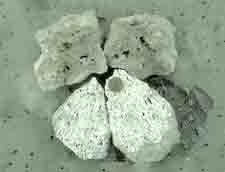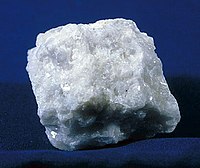- Igneous Rocks - This type of rock is formed by the cooling and solidifying of molten materials. These types of rock can be found beneath, or at, the Earth's surface as lava. An example of this type of rock is Pumice. Pumice is a light and porous rock formed by explosive volcanic eruptions. Below is a picture of Pumice.

- Metamorphic Rocks - A metamorphic rock is a rock that was once in one form and changed to another due to the exposure to eat, pressure, or some other experience. This process is called metamorphism. Much of the Earth's crust is made up of metamorphic rocks. Marble is a prime example of a metamorphic rock. Marble is composed of recrystallized carbonate materials, mostly dolomite or calcite. Below is a picture o marble.

- Sedimentary Rocks - This type of rock comes from the deposition and solidification of sediment. These rocks are often found in layers and commonly contain fossils. The Earth's crust is estimated to contain about 8% sedimentary rock. The study of this type of rock can provide useful information for civil engineers. An example of this rock would be Sandstone. Sandstone is a Clastic sedimentary rock formed mostly of sand-size minerals and rock grains. Below is a picture of Sandstone.

Types of Soils:
Gelisols, Histosols, Spodosols, Andisols, Oxisols, vertisols, aridisols, Ultisols, Mollisols, Alfisols, Inceptisols, Entisols







